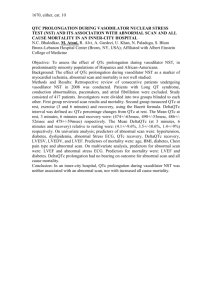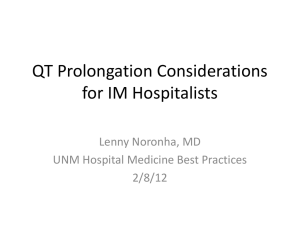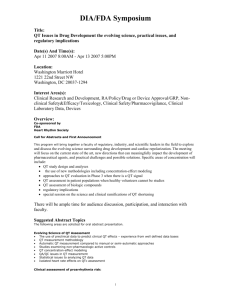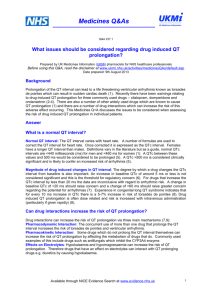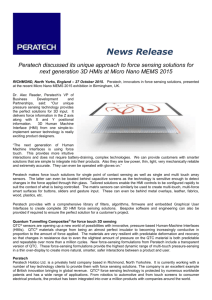The QT-interval
advertisement
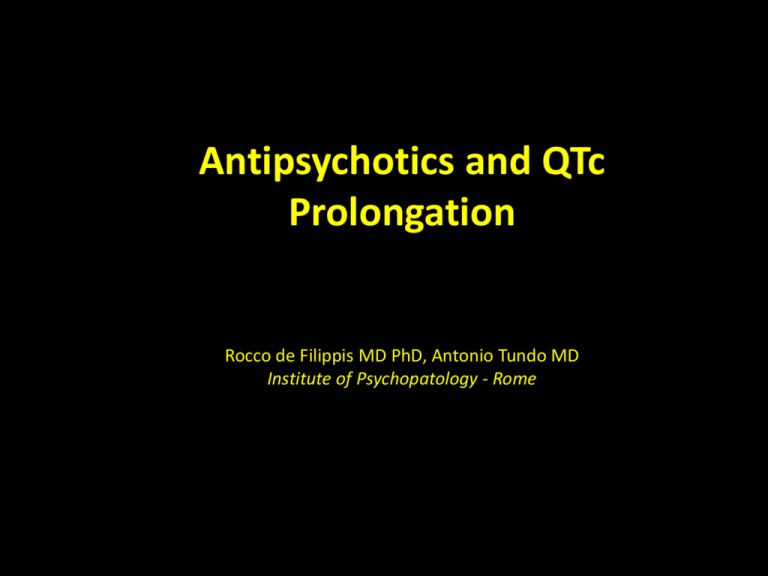
Antipsychotics and QTc Prolongation Rocco de Filippis MD PhD, Antonio Tundo MD Institute of Psychopatology - Rome Antipsychotics and QT Prolongation Antipsychotic medications have long been known to have the potential to cause QTc interval prolongation and torsades de pointes (TdP). Retrospective and cohort studies have linked antipsychotic use with sudden cardiac death, and most antipsychotic medications have been shown to cause some degree of QT prolongation. Arch Intern Med 2004; 164:1293–1297 Curr Drug Saf 2010; 5: 97–104. R&A The QT Interval On the electrocardiogram (ECG), the QT interval reflects the time from the onset of ventricular depolarization to the end of repolarization. R&A QT Interval and Significance • In cardiology, the time between the Q and T waves of an ECG is the QT interval • Normal QT interval is 0.30 - 0.44 (0.46 for women) seconds • If abnormally short or long, risk of developing various types of ventricular arrhythmias increases • Some QT prolongation can cause polymorphic ventricular tachycardia with a characteristic twist of the QRS complex around the isoelectric baseline, this is called Torsades de pointes (TdP) R&A R&A R&A PQRST • • • • • The P-Wave is caused by atrial contraction. The first upward deflection corresponds with the right atrium and the second downward deflection corresponds with the left atrium The P-Q-time or PR-Interval extends from the start of the P-wave to the very start of the QRS-complex. The excitation is decreased by the AV-node and led via the bundle of his to the left and right bundle branch (thus, conduction time). The normal duration is between 0.12 – 0.20 sec. A PR-interval of more than 0.20 sec may indicate a first degree an AV-block The QRS- Complex: The excitation is led via the left bundle branch and the ventricular septum and is visible as Q-wave n the ECG. During the R-phase most of the heart’s muscles are activated. For this reason the ECG shows the great wave. Whereas during the S-phase the activation runs from the apex of heart to the base of the right and left ventricle R&A PQRST • • • • QRS demonstrates the duration of the depolarization of the heart’s ventricles. A normal duration lies between 0.08 and 0.12 sec. If the duration is longer this may indicate a conduction abnormality as described before The QT-interval is measured from the beginning of the Q-wave to the end of the Twave. The QT-interval represents the duration of activation and recovery of the ventricular muscles. This duration is reciprocal to the pulse The ST-segment represents the period from the end of ventricular depolarization to the beginning of ventricular repolarization. Here all cells of the atria are depolarized. An isoelectric line is generated because in this segment there is no electrical current. The T-wave represents the repolarization of the ventricles and runs into the same direction as the R-wave. R&A Calculation of the QT Interval Automated QT and QTc Analysis on ECG Reliable with normal T waves at physiologic heart rates Unreliable: High heart rates Abnormal T wave Prominent U waves T-U wave complex morphology R&A TdP Normal R&A ECG Causes of Torsades de pointes • Many conditions may cause prolonged or abnormal repolarisation (that is, QT interval prolongation and/or abnormal T or T/U wave morphology), which is associated with Torsades de pointes (TdP) • If TdP is rapid or prolonged, it can lead to ventricular fibrillation and sudden cardiac death • Essentially, TdP may be caused by either congenital or acquired long QT syndrome (LQTS) • In recent years, there has been considerable renewed interest in the assessment and understanding of ventricular repolarisation and TdP. R&A Why Interest in TdP? 1. The cloning of cardiac ion channels has improved the understanding of the role of ionic channels in mediating cardiac repolarisation, the pathophysiological mechanism of LQTS (congenital and acquired forms), and the pathogenesis of TdP 2. Modern molecular techniques have unravelled the mutations in genes encoding cardiac ion channels that cause long QT syndrome, although the genetic defects in about 50% of patients are still unknown 3. Development and use of class III antiarrhythmic drugs which prolong repolarisation and cardiac refractoriness i. 4. Unfortunately, drugs that alter repolarisation have now been recognised to increase the propensity for TdP Finally, an increasing number of drugs, especially non-cardiac drugs, have been recognised to delay cardiac repolarisation and to share the ability with class III antiarrhythmics to cause TdP occasionally R&A A. Self Limiting Torsades de pointes (TdP) B. TdP Leading to Ventricular Fibrillation R&A Copyright ©2003 BMJ Publishing Group Ltd. Yap, Y. G. et al. Heart 2003;89:1363-1372 Calculation of the QTc.Formulae As repolarization is faster when the heart beats more rapidly, the QT interval should also be corrected for the heart rate. At least 17 unique QT correction formulas Bazett (QTc = QT/RR0.5) Fridericia (QTc = QT/RR0.33) Hodges (QTc = QT + 1.75[HR-60]) R&A CNS Drugs 2011:25; 473–490. Psychosomatics 2013:54:1–13 Correcting the QT Time for Heart Rate • Bazett formula: At a heart rate of 60 bpm, the RR interval is 1 second and the QTc equals QT/1 • Fridericia Formula: R&A How to measure QT if the QT segment is abnormal The T wave is broad, but the tangent crosses the baseline before the T wave joins the baseline. The QT interval would be overestimated when this last definition of the end of the T wave would be used. R&A How to measure QT if the QT segment is abnormal The ECG does not meet the baseline after the end of the T wave. Still, the crossing of the tangent and baseline should be used for measurements R&A How to measure QT if the QT segment is abnormal A bifasic T wave. The tangent to the 'hump' with the largest amplitude is chosen. This can change from beat to beat, making it more important to average several R&A measurements. Measuring QT Prolongation QTc values for normal and prolonged QT interval after correction with Bazett’s formula QTc values by age group and sex (ms) 1–15 years Adult males Adult females Normal <440 <430 <450 Borderline 440–460 430–450 450–470 Prolonged (top 1%) >460 >450 >470 R&A QTc Reference Values QTc Male (msec) Female (msec) Normal ≤430 ≤450 Borderline 431-450 451-470 Prolonged >450 >470 There is considerable intra- individual variability of the QTc: multiple studies have shown that it can vary by anywhere from 76 to 102 ms over the course of 24 hours. It has also been demonstrated that the QTc will increase during sleep and following a meal, by approximately 20 msec. ECG readings should be made at or near the maximum daily blood level of medications affecting the QT interval. Am J Psychiatry 2001; 158:1774–1782. Dtsch Arztebl Int 2011; 108(41): 687–93 R&A The QT Interval R&A Mechanism of Drug Induced QT Prolongation and Torsades de pointes • At the cellular level, the repolarisation phase of the myocytes is driven predominantly by outward movement of potassium ions • A variety of different K+ channel subtypes are present in the heart • Two important K+ currents participating in ventricular repolarisation are the subtypes of the delayed rectifier current – IKr ("rapid") and IKs ("slow") – Blockade of either of these outward potassium currents may prolong the action potential – IKr is the most susceptible to pharmacological influence. It is now understood that virtually without exception, the blockade of IKr current by these drugs is at least in part responsible for their pro-arrhythmic effect • Blockade of the IKr current manifests clinically as a prolonged QT interval (and the emergence of other T or U wave abnormalities on theR&A surface ECG) Mechanism of Drug Induced QT Prolongation and Torsades de pointes contd… • The prolongation of repolarisation results in subsequent inward depolarisation current, known as an early after-depolarisation When accompanied by increased dispersion of repolarisation, TdP is provoked, which is sustained by further re-entry or spiral wave activity • Such phenomena are more readily induced in the His-Purkinje network and also from a subset of myocardial cells from the mid ventricular myocardium, known as M cells • Compared to subendocardial or subepicardial cells, M cells show much more pronounced action potential prolongation in response to IKr blockade. Resulting in a pronounced dispersion of repolarisation (that is, heterogeneous recovery of excitability), creating a zone of functional refractoriness in the mid myocardial layer, which is probably the basis of the re-entry that is R&A sustaining the TdP. Arrhythmogenesis of torsades de pointes VF, ventricular fibrillation Yap, Y. G. et al. Heart 2003;89:1363-1372 R&A The QT Interval Ikr Channel: hERG controlled Antipsychotic dose-dependent blocking of Ikr channels has been described. R&A (Drolet1999,;TieH2000) Generic Name Brand Name Class/Clinical Use Comments Amiodarone Amiodarone Arsenic trioxide Astemizole Bepridil Chloroquine Chlorpromazine Cordarone® Pacerone® Trisenox® Hismanal® Vascor® Aralen® Thorazine® Anti-arrhythmic / abnormal heart rhythm Anti-arrhythmic / abnormal heart rhythm Anti-cancer / Leukemia Antihistamine / Allergic rhinitis Anti-anginal / heart pain Anti-malarial / malaria infection Anti-psychotic/ Anti-emetic / schizophrenia/ nausea Females>Males,TdP risk regarded as low Females>Males,TdP risk regarded as low Cisapride Clarithromycin Disopyramide Dofetilide Domperidone Droperidol Propulsid® Biaxin® Norpace® Tikosyn® Motilium® Inapsine® Erythromycin Erythrocin® Erythromycin E.E.S.® Halofantrine Halfan® Haloperidol Haldol® Ibutilide Levomethadyl Mesoridazine Methadone Corvert® Orlaam® Serentil® Dolophine® GI stimulant / heartburn Restricted availability; Females>Males. Antibiotic / bacterial infection Anti-arrhythmic / abnormal heart rhythm Females>Males Anti-arrhythmic / abnormal heart rhythm Anti-nausea / nausea Not available in the U.S. Sedative;Anti-nausea / anesthesia adjunct, nausea Antibiotic;GI stimulant / bacterial infection; increase GI Females>Males motility Antibiotic;GI stimulant / bacterial infection; increase GI Females>Males motility Anti-malarial / malaria infection Females>Males When given intravenously or at higher-thanrecommended doses, risk of sudden death, QT Anti-psychotic / schizophrenia, agitation prolongation and torsades increases. Females>Males Anti-arrhythmic / abnormal heart rhythm Opiate agonist / pain control, narcotic dependence Anti-psychotic / schizophrenia Opiate agonist / pain control, narcotic dependence Females>Males Methadone Methadose® Opiate agonist / pain control, narcotic dependence Females>Males Pentamidine Pentam® Anti-infective / pneumocystis pneumonia Females>Males Pentamidine Pimozide Probucol Procainamide Procainamide Quinidine Quinidine Sotalol Sparfloxacin Terfenadine Thioridazine NebuPent® Orap® Lorelco® Pronestyl® Procan® Cardioquin® Quinaglute® Betapace® Zagam® Seldane® Mellaril® Anti-infective / pneumocystis pneumonia Anti-psychotic / Tourette's tics Antilipemic / Hypercholesterolemia Anti-arrhythmic / abnormal heart rhythm Anti-arrhythmic / abnormal heart rhythm Anti-arrhythmic / abnormal heart rhythm Anti-arrhythmic / abnormal heart rhythm Anti-arrhythmic / abnormal heart rhythm Antibiotic / bacterial infection Antihistamine / AllergicR&A rhinitis Anti-psychotic / schizophrenia Females>Males Females>Males No longer available in U.S. No Longer available in U.S. Females>Males Females>Males Females>Males Females>Males No longer available in U.S. Characteristic Sequence before the Onset of TdP • The first ventricular complex of the sequence is usually a ventricular ectopic beat or the last beat of a salvo of ventricular premature beats. This is then followed by a compensatory pause terminated by a sinus beat. The sinus beat frequently has a very prolonged QT interval and an exaggerated U wave. A ventricular extrasystole then falls on the exaggerated U wave of the sinus beat and precipitates the onset of TdP. It has been suggested that post-pause accentuation of the U wave, if present, may be a better predictor of drug induced TdP than the duration of QTc interval. R&A Rhythm Strip in a Patient with Drug Induced TdP Note the typical short-long-short initiating ventricular cycle, pause dependent QT prolongation, and abnormal TU wave leading to the classical "twisting of a point" of the cardiac axis during TdP. R&A Yap, Y. G. et al. Heart 2003;89:1363-1372 Measuring QT Prolongation • For QT, ECG is best recorded at a paper speed of 50 mm/s and at an amplitude of 0.5 mV/cm using a multichannel recorder capable of simultaneously recording all 12 leads • A tangent line to the steepest part of the descending portion of the T wave is then drawn. The intercept between the tangent line and the isoelectric line is defined as the end of the T wave • The QT interval is measured from the beginning of the QRS complex to the end of the T wave on a standard ECG – There are no available data on which lead or leads to use for QT interval measurement – Traditionally, lead II has been used for QT interval measurement because in this lead, the vectors of repolarisation usually result in a long single wave rather than discrete T and U waves R&A Measuring QT Prolongation • Generally, QT prolongation is considered when the QTc interval is greater than 440 ms (men) and 460 ms (women), although arrhythmias are most often associated with values of 500 ms or more • The severity of pro-arrhythmia at a given QT interval varies from drug to drug and from patient to patient. Unfortunately, the extent of QT prolongation and risk of TdP with a given drug may not be linearly related to the dose or plasma concentration of the drug because patient and metabolic factors are also important (for example, sex, electrolyte concentrations, etc) • Furthermore, there is not a simple relation between the degree of drug induced QT prolongation and the likelihood of the development of TdP, which can occasionally occur without any substantial prolongation of the QT interval. R&A The QT interval start at the onset of the Q wave and ends where the tangent line for the steepest part of the T wave intersects with the baseline of the ECG. The normal value for QTc(orrected) is: below 450ms for men and below 460ms for women R&A Effect of Various Fluoroquinolones on Prolonging Action Potential Duration R&A Yap, Y. G. et al. Heart 2003;89:1363-1372 The QT Interval hERG channel affinities for Antipsychotics In addition to HERG channel/receptor affinities, pharmacokinetic considerations will also determine the potential for a drug to prolong QTc interval. For this limited series of drugs, the ratio of total plasma concentration to HERG IC50 appeared to correspond well with the observed changes in QTc. European Journal of Pharmacology 450 (2002) 37– 41 R&A The QT Interval.INa Channel R&A Journal of Psychopharmacology 2014, Vol. 28(4) 329– 340 Drug related factors inducing QTc Prolongation Drug-Drug Interactions Farmacokinetic Farmacodynamic Drug-Gene Interactions Genetic Polimorphisms R&A Drugs associated with QTc Prolongation and Antipsychotic PK and PD Interactions Pharmacokinetic drug-drug interactions involving the cytochrome P450 (CYP) 3A4 and 2D6 enzymes occurred commonly. It is surprising to note that CYP450 1A2 nteractions were involved in 32/162 (19.8%) of the PK DDIs found in this study. Cardiac death occurs in a large number of patients and it is unknown how many of these deaths are due to unintended and unmonitored QTc prolongation from DDIs. R&A Journal of Critical Care (2013) 28, 243–249 Psychotropic drugs association and QTc Prolongation In clinical practice, combination of psychotropic drugs that affect myocardial repolarization and prolong the QTc, is very frequent. Slow CYP2D6 metabolizers and patients concomitantly taking other drugs that inhibit CYP2D6, such as fluoxetine, paroxetine, bupropion, duloxetine, venlafaxine and trazodone are at particularly elevated risk. Moreover combination of antipsychotics increase the risk of QTc Prolongation. R&A Journal of Critical Care (2013) 28, 243–249 Psychopharmacology (2013) 228:515–524 Psychotropic drugs association and QTc Prolongation R&A Drug Metabolism and QTc Prolongation R&A Katzung B.G.Basic and Clinical Pharmacology 2012. R&A R&A R&A The QTc Prolongation and Antipsychotics R&A J Clin Psychopharmacol.2004. 24:62–69 The QTc Prolongation and Antipsychotics R&A The Lancet 2013:382;951-962 The QTc Prolongation and Antipsychotics Journal of Clinical Psychopharmacology 31; 4, August 2011 R&A The QTc Prolongation and the Risk of Torsade de Pointes Prolonged QTc may be associated with dizziness, lightheadedness, palpitations, presyncope or syncope, and ventricular tachyarrhythmias including polymorphic ventricular tachycardia or torsades de pointes (TdP). While most cases of TdP resolve spontaneously, some may degenerate into ventricular fibrillation and sudden cardiac death if not treated promptly with cardiopulmonary support and cardioversion. R&A The QTc Prolongation and the Risk of Torsade de Pointes R&A Psychosomatics 2013:54:1–13 Torsade de Pointes and Antipsychotics A QTc above 500 ms represents a risk factor for TdP. Although a link exists between QTc and TdP, this link is neither linear nor straightforward. Curr Drug Saf 2010; 5:97–104 Prog Cardiovasc Dis 2003; 45:415–427 R&A Torsade de Pointes and Antipsychotics TdP is rare. Many TdP cases escape clinical detection because no ECG is recorded. When interpreting TdP case numbers, one must bear in mind the frequency with which different antipsychotics are prescribed. For some drugs, in fact, there have been no relevant studies or reports at all. R&A R&A Conclusions • Drug induced QT prolongation and torsades de pointes are an increasing public health problem • The blockade of IKr potassium current by these drugs is responsible for their pro-arrhythmic effect • Measurement of QT interval should be corrected for heart rate • Antiarrhythmic drugs, non-sedating antihistamines, macrolides antibiotics, antifungals, antimalarials, tricyclic antidepressants, neuroleptics, and prokinetics have all been implicated in causing QT prolongation and/or torsades de pointes • Co-administration of multiple drugs, especially with other QT prolonging drug(s) and/or hepatic cytochrome P450 CYP3A4 isoenzyme inhibitors, must be avoided R&A Conclusions • The risk of QT prolongation is increased in females, patients with organic heart disease (for example, congenital long QT syndrome, myocardial infarction, congestive heart failure, dilated cardiomyopathy, hypertrophic cardiomyopathy, bradycardia), hypokalaemia, and hepatic impairment • The treatment of drug induced torsades de pointes includes identifying and withdrawing the offending drug(s), replenishing the potassium concentration to 4.5–5 mmol/l, and infusing intravenous magnesium (1–2 g). In resistant cases, temporary cardiac pacing may be needed R&A Treatment Recommendation 1)Baseline ECG prior to treatment and under steady –state conditions afterward. 2)Regular ECG monitoring of patients at high risk and those taking additional medications that can prolong the QTc interval. 3) Slow dose escalation and adaptation of the dose in case of altered elimination or concurrent medication sharing the same metabolic pathway. 4)Periodic electrolyte monitoring.In particular,in case of diarrhea, vomiting, profuse sweating, undernourishment, alcohol/drug use and Diuretic therapy 5) Administration of magnesium sulfate (orally or intravenously) if the QTc interval is markedly prolonged. 6) Discontinuation of medication if the QTc is longer than 500 ms, the potassium concentration is normal, and the QRS is of normal duration, even if the patient has no symptoms. R&A Antipsychotics ,QTc Prolongation and the Elderly In the Elderly High Rates of Psychotic Depression. High Rates of Anxiety Disorders Refractory to Standard Treatment. Increased risk of Delirium. Behavior Abnormalities due to Dementia. J Clin Psychopharmacol 2014; 34: 109-123 Psychiatry and Cardiovascular Disease : 2009; 17 ;-5 R&A Risk Stratification A. Mild Risk for QTc Interval Prolongation (Patients Who Are in Relatively Good Physical Health) a) No current cardiovascular symptom or disease, and no history of severe CVD b) Normal EKG with pretreatment QTc interval less than 450 milliseconds c) Absence of other diseases that are known to predispose to QTc interval prolongation (Table I) d) No concurrent cardiac or noncardiac medication that could increase QTc interval B. Moderate Risk for QTc Interval Prolongation (Patients Who Have a Few Risk Factors i) a) Current stable cardiovascular function: no current cardiovascular symptoms or disease but with past history of CVD b) EKG abnormalities from past cardiovascular events that have little or no current clinical significance . c) Presence of noncardiac diseases that could impact QTc interval, or two or more diseases listed in Table I d) Concurrent use of at least one noncardiac medication known to prolong QTc interval e) History of stroke with residual neurological deficits f) a, b, c, and d or mildly elevated QTc interval of 450-470 milliseconds C. High Risk for QTc Interval Prolongation a) Presence of active cardiac disease or symptoms b) Presence of multiple other risk factors listed in Table I R&A Psychiatry and Cardiovascular Disease 17 -;5 : 2009 Treatments Guidelines A. Mild Risk for QTc Interval Prolongation (Patients Who Are in Relatively Good Physical Health) a) For these patients, a baseline EKG prior to initiation of antipsychotic therapy and annual reassessment of QTc interval prolongation risk will suffice. b)Regarding choice of antipsychotic medication, those known to have lower QTc interval prolongation are generally preferred. c) Ziprasidone may be used in these patients, but only as a third-line option and with regular EKG monitoring. B. Moderate Risk for QTc Interval Prolongation (Patients Who Have a Few Risk Factors i) a) In these patients with moderate risk of QTc prolongation, alternative psychotropic medications should be considered (eg, mood stabilizers or antidepressants). b)Cardiology consult is recommended for joint management. c) Ziprasidone and all low- and mid-potency traditional antipsychotic medications are not recommended. d)Prior to initiating antipsychotic medication, baseline EKG, optimum management of preexisting diseases, and alternatives to noncardiac medications capable of prolonging QTc interval should considered. e)A much lower dose and very slow titration of antipsychotic medications is recommended. g)Serial EKG’s recordings may be helpful to adjust for daily variations in the QTc interval. h) In patients with moderate risk, any upward trending of QTc interval prolongation is an indication to discontinue antipsychotic therapy. R&A Websites Resources www.qtdrug.org www.torsade.org R&A THANK YOU R&A

